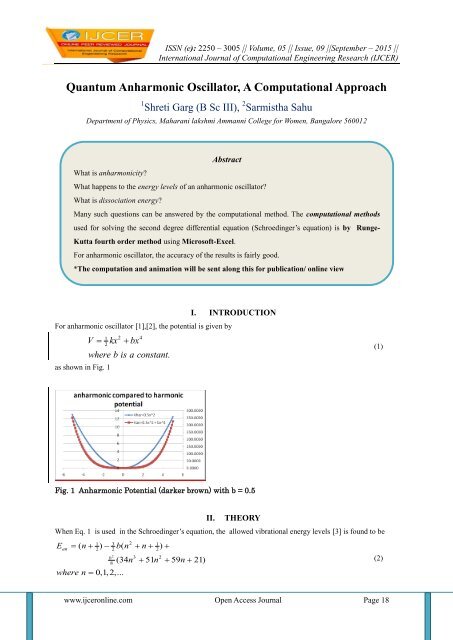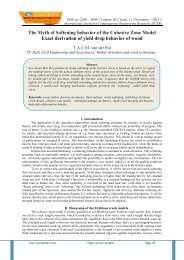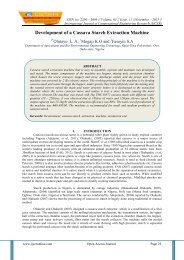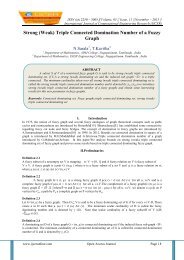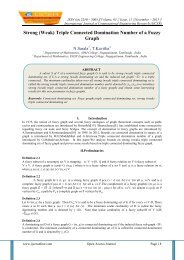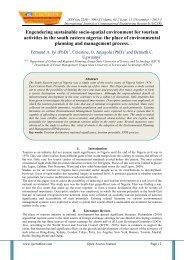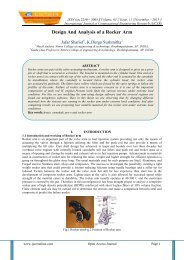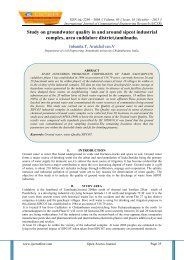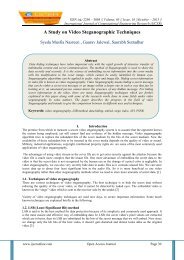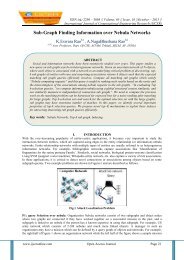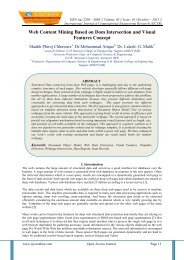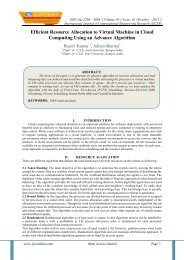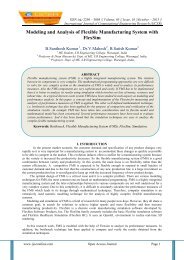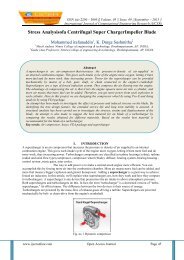Quantum Anharmonic Oscillator, A Computational Approach
You also want an ePaper? Increase the reach of your titles
YUMPU automatically turns print PDFs into web optimized ePapers that Google loves.
ISSN (e): 2250 – 3005 || Volume, 05 || Issue, 09 ||September – 2015 ||<br />
International Journal of <strong>Computational</strong> Engineering Research (IJCER)<br />
<strong>Quantum</strong> <strong>Anharmonic</strong> <strong>Oscillator</strong>, A <strong>Computational</strong> <strong>Approach</strong><br />
1 Shreti Garg (B Sc III), 2 Sarmistha Sahu<br />
Department of Physics, Maharani lakshmi Ammanni College for Women, Bangalore 560012<br />
Abstract<br />
What is anharmonicity?<br />
What happens to the energy levels of an anharmonic oscillator?<br />
What is dissociation energy?<br />
Many such questions can be answered by the computational method. The computational methods<br />
used for solving the second degree differential equation (Schroedinger’s equation) is by Runge-<br />
Kutta fourth order method using Microsoft-Excel.<br />
For anharmonic oscillator, the accuracy of the results is fairly good.<br />
*The computation and animation will be sent along this for publication/ online view<br />
For anharmonic oscillator [1],[2], the potential is given by<br />
V kx bx<br />
1<br />
2<br />
as shown in Fig. 1<br />
2 4<br />
where b is a constant.<br />
I. INTRODUCTION<br />
(1)<br />
Fig. 1 <strong>Anharmonic</strong> Potential (darker brown) with b = 0.5<br />
II. THEORY<br />
When Eq. 1 is used in the Schroedinger’s equation, the allowed vibrational energy levels [3] is found to be<br />
E ( n ) b( n n ) <br />
an<br />
1 3 2 1<br />
2 2 2<br />
2<br />
b<br />
8<br />
where n 0,1,2,...<br />
3 2<br />
(34n 51n 59n<br />
21)<br />
(2)<br />
www.ijceronline.com Open Access Journal Page 18
<strong>Quantum</strong> <strong>Anharmonic</strong> <strong>Oscillator</strong>, A <strong>Computational</strong>…<br />
Thus, the anharmonic oscillator behaves like the harmonic oscillator but with an oscillation frequency that<br />
decreases steadily with increasing n.<br />
For the ground state (n = 0) we have<br />
E b b<br />
(3)<br />
2<br />
0an<br />
0.5 1.5 *0.5 0.125 *21<br />
The energy difference between consecutive levels decreases successively. Finally, when the energy difference is<br />
zero, the corresponding potential energy is a measure of the dissociation energy of the molecule.<br />
III. METHODOLOGY<br />
The computational output is obtained using Microsoft Excel .Runge Kutta Fourth Order is used for solving<br />
the Schroedinger’s second degree ordinary differential equation. Of course, animation is done using graphics.<br />
IV. RESULT<br />
o The energy is lesser than the harmonic oscillator [4] given by<br />
2<br />
3 2 1 b 3 2<br />
E b( n n ) (34n 51n 59n<br />
21)<br />
(4)<br />
2 2 8<br />
The energy difference decreases with the increase of the quantum number n as shown below. On the other hand,<br />
the energy difference remains a constant for a harmonic oscillator.<br />
Table 1. Comparison of energy in <strong>Anharmonic</strong> (Ean) and Harmonic <strong>Oscillator</strong>s (Ehar)<br />
For b= 0.001<br />
n Ean<br />
ΔEan=En+1-<br />
En Ehar<br />
0 0.499 0.5<br />
1 1.496 0.997 1.5<br />
2 2.490 0.994 2.5<br />
3 3.481 0.991 3.5<br />
4 4.469 0.988 4.5<br />
5 5.454 0.985 5.5<br />
6 6.435 0.982 6.5<br />
7 7.413 0.978 7.5<br />
8 8.389 0.975 8.5<br />
9 9.361 0.972 9.5<br />
.. ..<br />
100 81.035 100.5<br />
101 81.602 0.567 101.5<br />
.. ..<br />
150 102.036 150.5<br />
151 102.292 0.256 151.5<br />
www.ijceronline.com Open Access Journal Page 19
<strong>Quantum</strong> <strong>Anharmonic</strong> <strong>Oscillator</strong>, A <strong>Computational</strong>…<br />
.. ..<br />
175 106.325 175.5<br />
176 106.402 0.077 176.5<br />
.. ..<br />
185 106.755 185.5<br />
186 106.756 0.001 186.5<br />
187 106.749 -0.007 187.5<br />
o The dissociation energy is ~ 106.756 units [5].<br />
ACKNOWLEDGEMENT<br />
I am grateful to my teacher, Prof. Sarmistha Sahu who has taught me numerical methods and Microsoft Excel.<br />
She has helped me complete this project successfully.<br />
REFERENCES<br />
[1] RC Verma, PK Ahluwalia, KC Sharma, <strong>Computational</strong> Physics An introduction, New Age International Publishers pp (1999)<br />
[2] Eyvind Wichman, “<strong>Quantum</strong> Physics”, Berkeley Physics Course, Vol 4 McGraw Hill Companies Inc.(2011)<br />
[3] Sarmistha Sahu, “Concise Physics”, Vol 5 Statistical Physics and <strong>Quantum</strong> Mechanics, Subhas Stores (2013)<br />
[4] Sarmistha Sahu, <strong>Quantum</strong> Harmonic <strong>Oscillator</strong>, European Journal of Physics, (Submitted)<br />
[5] C N Banwell, Fundamentals of Molecular Spectroscopy Tata McGraw-Hill Publishing Company Limited , 3 rd ed (1983)<br />
www.ijceronline.com Open Access Journal Page 20


